| Photographs of the inside of Chubb's Wednesfield
Road Works are very few, and far between. Luckily for
us, ex-Chubb employee, the Reverend Bill Enoch, has
kindly passed-on the following photographs that were
mainly taken in the 1950s. He has also written about his
memories of the company, and these are included below.
The factory, now demolished, covered about 10 acres, and
several hundred people were employed there. The
following photographs show some of the highly skilled
workforce, at a time when Wolverhampton could be
justifiably proud if it's world-leading manufacturer of
safes and strong rooms.
The Reverend Bill
Enoch's Memories of the Company
My earliest
memory of the factory would be during the war years when
I passed it each day, either on my bike or on the
single-decker trolley bus, on the way to school. The
drive was full of newly-completed Bren gun carriers,
which were obviously part of Chubb's war-time effort.
In February
1952, not long after completing National Service in the
R.A.F. I joined the company as a clerk in the Programme
Control Dept. I was put to work with Charlie Grainger
who taught me a great deal about the company, its
products, its history, and its place in the lock and
safe industry. |
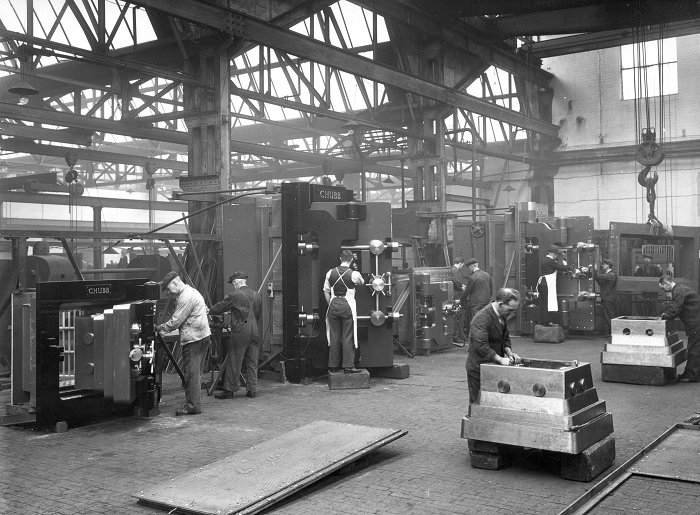
Strong room doors under
construction in the early 1950s. The small doors are emergency exit
doors, built to the same specification as the main
doors. They were used in an emergency when there was a
"lock-out" on the main door. |
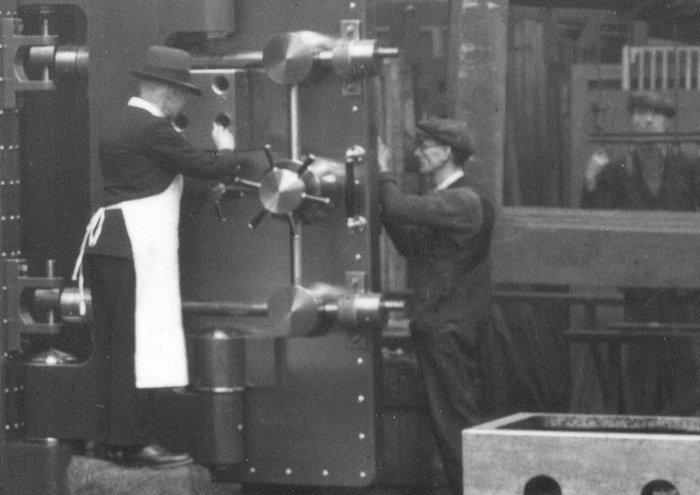
An enlarged view from the
photograph above, showing part of the complex locking
mechanism on a strong room door. |
|
I soon
discovered that there was great pride in the company and
its reputation, and as my job involved spending a lot of
time on the shop-floor, I came to realise that this
pride existed at all levels. The reason wasn't hard to
find. Chubb had held the Royal Appointment since the
1830's, and also supplied locks and safes to government
departments and major banks, both here and abroad. They
were probably the best-known lock and safe maker in the
world, as well as being one of the oldest. They had
factories in all the old Commonwealth countries, and
agents all over the world.
The fact that
Chubb was still very much a family business probably
contributed to this sense of pride, especially as "Mr
George", (more properly the Honourable George Chubb) was
frequently to be seen at the factory, and was respected
there. In fact it was generally felt that the company
was run by gentlemen. |
|
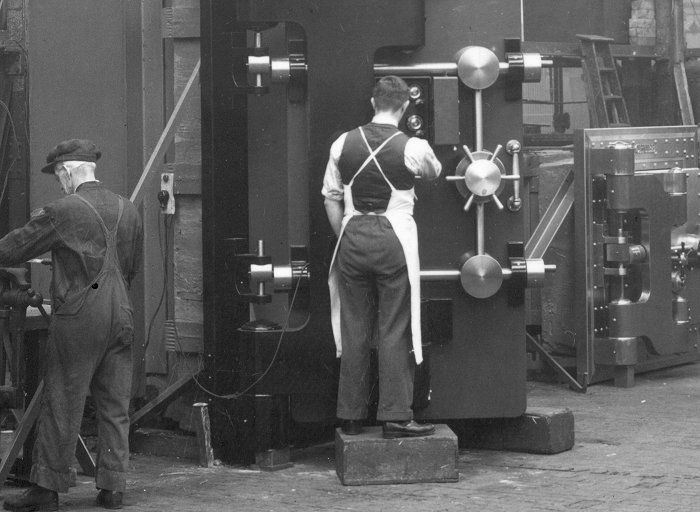
Another strong room door, a
little nearer completion. |
|
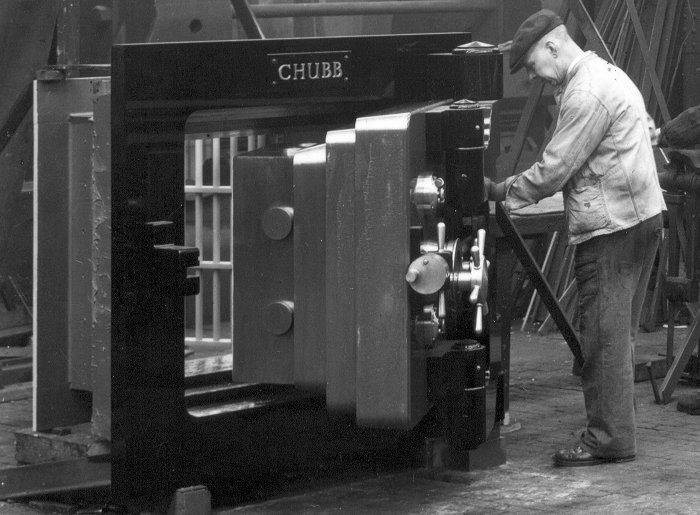
One of the emergency exit
doors nearing completion. |
|
When
particularly impressive strong room doors or safe
deposits were made, usually for overseas banks, the
families of employees would be invited to inspect them
on the shop floor before they were crated up and sent to
the docks. It was common to find Chubb workers who
started straight from school and stayed until they
retired half-a-century or more later. Many of them lived
within walking distance of the factory.
In the early
1950's one would see only two motor cars in the drive.
These belonged to the Works Director, Mr Rushton, and
the Works Manager Mr Long. For the rest there would be a
couple of dozen motor-bikes and about 500 cycles in the
bike-shed. Everyone else walked home or made for the bus
stops outside the main gates. By the mid 1980s when I
finally left the company there were probably 500
employees’ cars.
Beneath the
factory there was a rifle range, built for the Home
Guard during the war. After the war they formed the
Chubb Rifle Club, which I joined and eventually became
secretary. We competed very successfully in various
Wolverhampton and Black Country Rifle Leagues. |
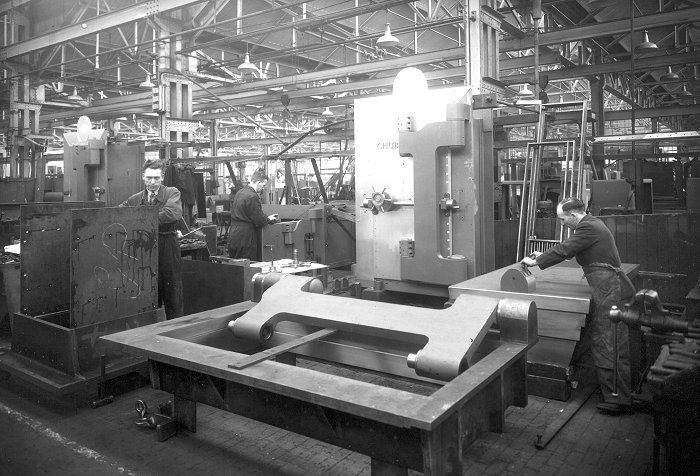
More strong room doors under
construction in the early 1950s. The gentlemen in the foreground
are George Palmer and Albert Booth. |
|
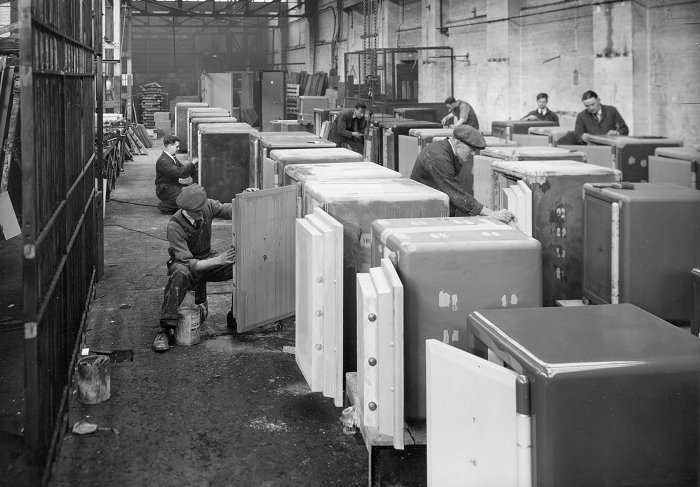
Chubb office quality safes
being painted in the early 1950s. |
|
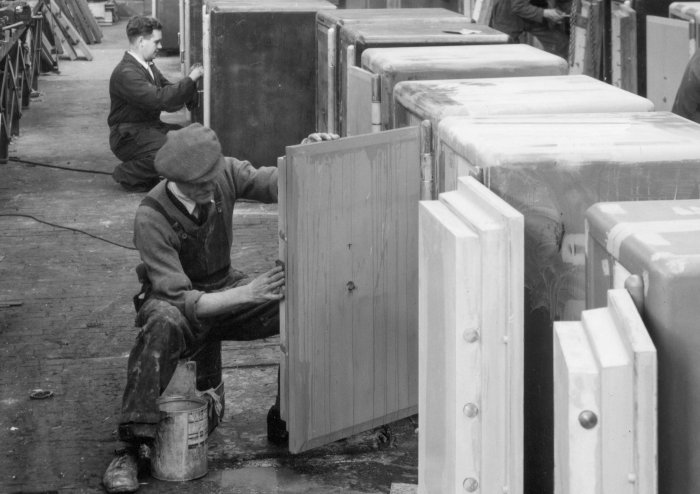
Another view of painting in
progress. |
|
Names come to
mind from my early days:- Bert Tooby the Chief
Draughtsman, and David Tate who took over when Mr. Tooby
retired. Leslie Tinkler, and Jimmy McGee who were the
estimators. There was George Dean the time study chap,
Reg Milne the chief accountant and Les James who worked
for him, John Jeavons, my boss, and Stan Reese who ran
the shipping department.
Gerry Cox was
the Safe Works foreman, and later Arthur Gandy. George
Prior was in charge of Progress, and Bob Kilvert who
could get a bet on for you in those puritan days. Jack
Walker was in charge of the paint shop and his two sons
worked with him, and Jack Beech was the light Shop
foreman, and two of my many brothers-in-law, Ray Wilkes
the works union convenor and Saiah Wilkes a painter.
Ivor Jennings;
always known as “Bubble" for reasons I never discovered,
and Les Minshall, Albie Booth, George Palmer, Frank
Morris who shot with me in the Rifle Club. Characters,
every one of them. |
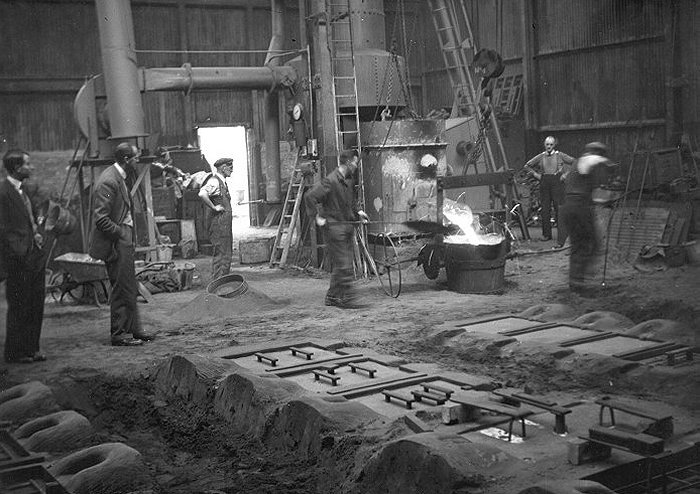
Filling a ladle with A.B.P.
alloy (anti-blowpipe alloy) from a furnace in around
1950. The man in the
light suite on the left, with his hands in his pockets
is G.C.H. Chubb, later Lord Hayter. |
|
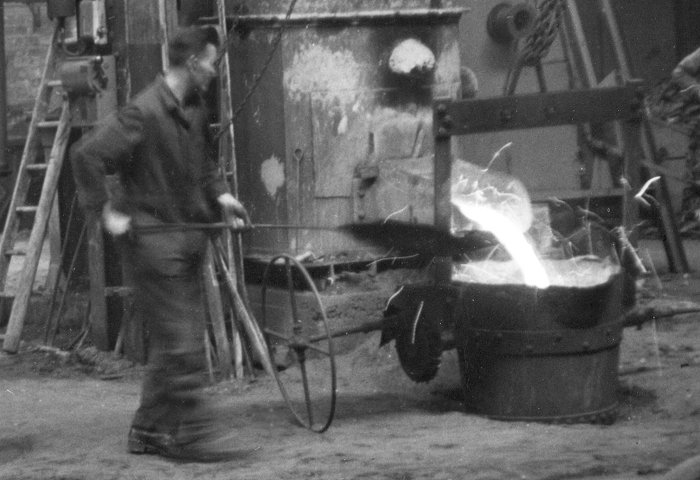
A close-up view of the ladle
being filled from the furnace. |
|
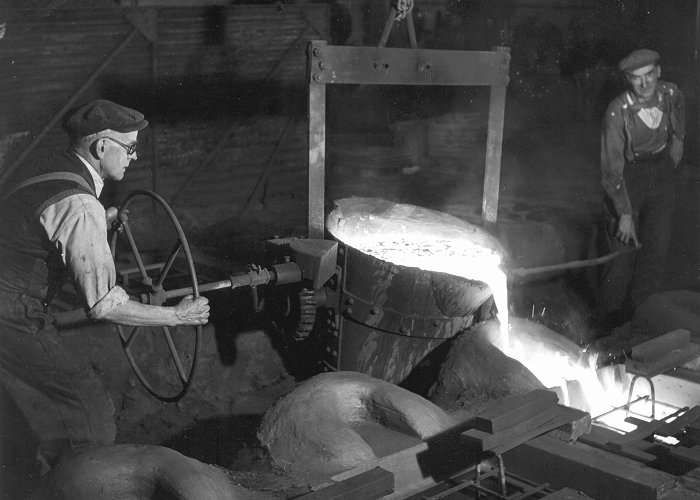
Casting A.B.P.
alloy (anti-blowpipe alloy) in the early
1950s. |
|
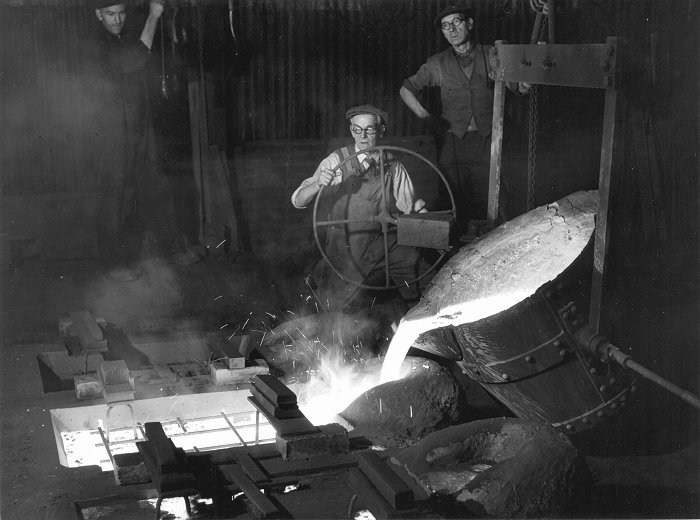
Another view showing the
casting of A.B.P. alloy (anti-blowpipe alloy) in the
early 1950s. |
|
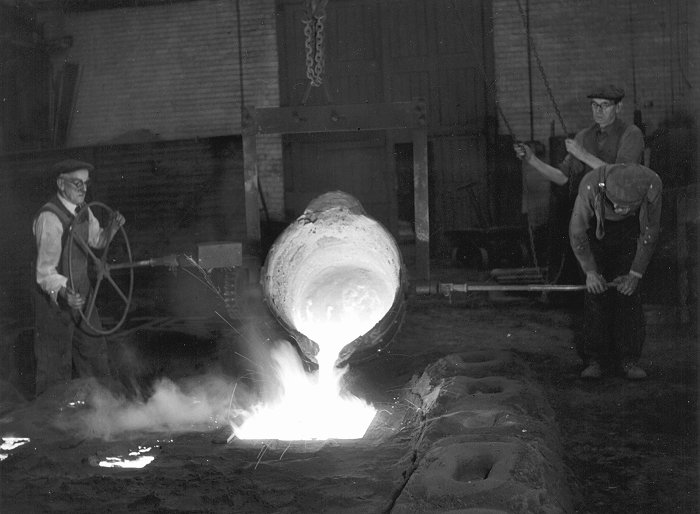
A final view of
A.B.P. alloy casting. |
|
Before the
1950's were out Chubb began to expand. New designs and
materials were always necessary in the constant battle
to keep safes one step ahead of the villains. Better
fire resisting cabinets were developed to meet the need
to protect vital records including computer media. Chubb
Research came into being with highly sophisticated
design and testing facilities. Some demonstrations of
their testing were done before select audiences invited
from police, military and insurance bodies.
Many high
security locks were redesigned so that they could be
mass-produced rather than hand-made by locksmiths,
although these highly-skilled men remained in demand for
the really specialist locks. The Wednesfield Road site
must have doubled in size during the 60's and 70's. |
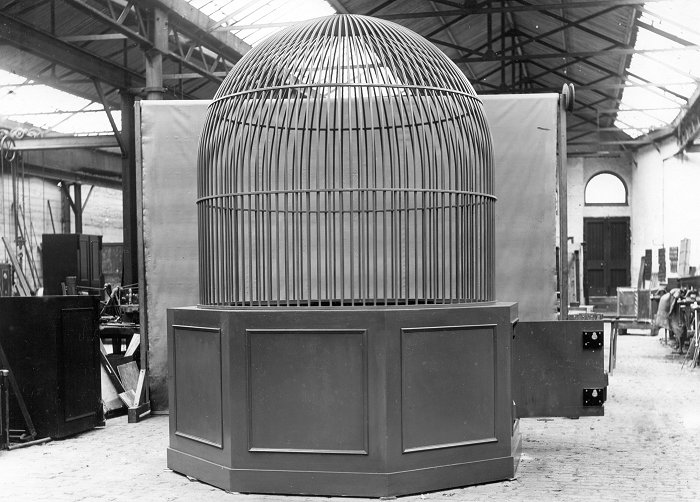
A special case made for
exhibiting the crown jewels. Chubb held the Royal
warrant from around 1840. The photograph was taken in the
late 19th century. |
|
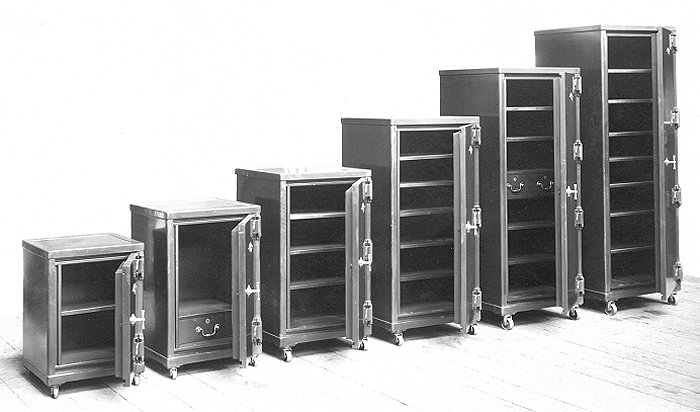
Chubb certified
fire-resisting cabinets, sizes 1 to 6. From
the 1930s. |
|
The eventual
decline of safe-making seems linked to changes in
society itself. For more than a century Chubb had made
ever stronger and more sophisticated safes in answer to
increasingly skilled and resourceful safe-breakers.
Sometimes it seemed that the villains got ahead, in
which case Chubb had to come up with something better,
until the next legitimate advance in cutting or boring
techniques which might give the criminal the edge. And
so on.
But there came a
time when money began to go out of fashion as we all
swapped our cash for bits of plastic. The need for the
big Chubb safes and strong-room doors began to dry up,
especially as the safe-makers at that moment in time
were well ahead of the safe-breakers. The villains
changed tack, finding it preferable to attack cash in
transit rather than knock themselves out on safes they
weren’t going to get into. The rest, alas, is history. |
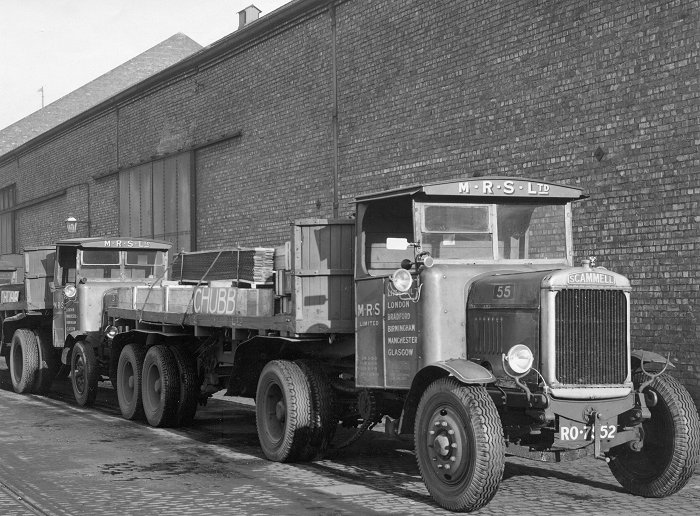
Chubb strongroom reinforcement
"Tangbar" and other items about to be transported from
the works. Possibly in the 1920s or 1930s. |
The following photographs were
kindly sent in by Adam Morris who worked at the
Wednesfield Road site from 1979 when he started as
an apprentice, until 2001 when it closed. He trained
in the Quality Department, before moving on to
CNC machines in 1987, at a time when there were over
1,000 employees at the works.
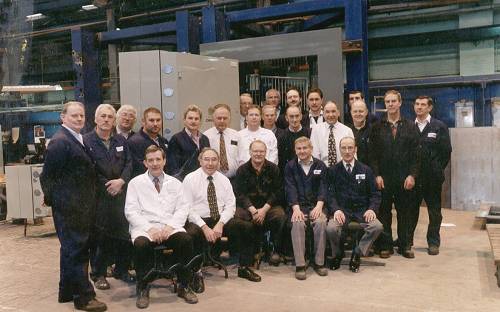
The official staff
photograph taken after the manufacture of a
pair of doors for the King of Brunei, around
1995. Courtesy of Adam Morris. |
|
Left to right: |
|
|
Back row: |
? , Mick Beeston, Norman Stevens,
Mac Gardiner, Adam Morris. |
|
Middle row: |
George Fones, Terry Pallant, Geoff
Dunn, Steve Lloyd, Den Deg, Roger Green,
Andy Burgiss, Pete Swan, Brian Jones,
Sid Hobbs, Albert Rhodes, Roy Stanley,
Terry Bloomer. |
|
Front row: |
Bill Hickman, Alan Kimber, Mac
Evans, Ron Alcock, Alan Jones |
The following two photographs show the front and back
page of Adam's Apprenticeship Indentures, signed by Mr
Charles Barton, the MD at the time. Chubb used to take
on around 20 craft apprentice's each year, at
Wednesfield Road, up until about 1982. They also had
Technical Apprentices and Commercial Apprentices. The
in-house training centre had its own Fitting and Bench
Shop, a separate Machine shop, and a staff of four. In
the early to mid 1980s the training school moved to the
Josiah Parkes site.
I must thank Michael Stevens for kindly sending the
following photos, and Will Morgan for some of the names. The first two are of the Chubb rifle
team, who won the Bird Trophy in 1964. They were
gathered together to celebrate their success, and were
photographed at Chubb's Rifle Range which was under the
factory floor.
|
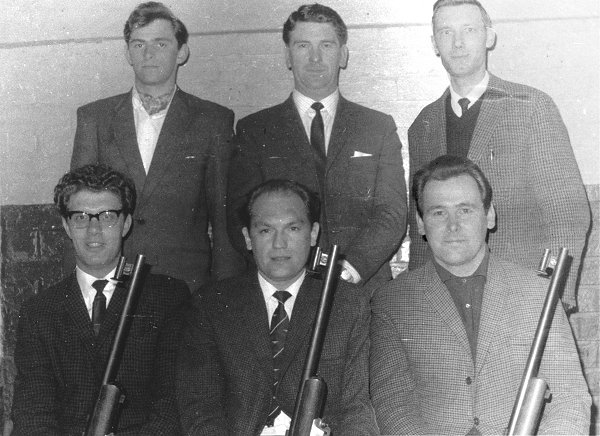 |
| Left to right:
Front row - Bill Heritage, Ken Bould, Bill Enoch (club
secretary).
Back row - Michael Stevens, Harry Saich,
Councillor Alan Beste |
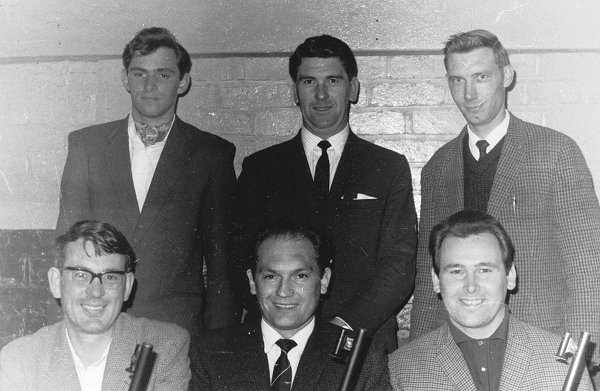
The same people as on the previous photo
except that first left on the front row is Les
James.
In the rifle range the targets were attached to a
trolley that ran on rails. It was positioned by a rope
and pulley system, similar to that seen in the film "The
Great Escape". It was done this way because of the lack
of roof space. If the trolley de-railed, as it would if
the operator was impatient, it was quite an ordeal to
crouch down and waddle along in order to put matters
right. The rifles used were BSA Martini, lever action,
single shot .22 calibre.
On one occasion, a club member brought a pistol
to try out, and without checking, fired a couple
of rounds down the range. Unfortunately, the
trolley with the targets had de-railed and
another member was some distance down range and
not clearly in view. The ensuing altercation was
quite amusing, to say the least.
|

The Bird Trophy. |
The range was unique. The outer door
lead directly into a small room, where
the guns and ammunition were secured.
The roof was just above head height.
The shooting positions, of which there
were two, were on a raised level at
about waist height, which was constant
from that point onwards down the range.
It was quite common to be lying in the
prone shooting position and hear the
large and very heavy safes being
trundled about in the workshops directly
above.
Having a fertile imagination was not
an asset, and it was no wonder some
members developed a certain reluctance
to shoot when the floor above started
creaking. |
Michael also sent the following two photos of a
version of a Chubb safe that was produced by Wedgwood.
|
If anyone can add to the story,
or has any photographs of the works, please contact
Bev Parker.
 |
Return to the
Chubb menu |
|
|